
The idea of this project is to easy detect if the postman has put some letter’s in the box … or not. Problem, i live…

This is, two files written to get data from SigFox backend, one to get message list, and other one to get the device type, it’s…

Last week, I had the chance to attend the SigFox maker’s tour in Paris, it was very interesting to learn more about this amazing technology….

I « rebuild » my Geiger counter, the SBM-20 tube was initially inside the box, so, i have put this one inside a 32mm diam plastic tube,…
